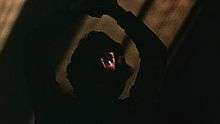Billy (Black Christmas)
| Billy | |
|---|---|
| Black Christmas character | |
 | |
| First appearance |
Black Christmas (1974) |
| Last appearance |
Black Christmas (2006) |
| Created by |
A. Roy Moore Bob Clark |
| Portrayed by |
Black Christmas (1974) Bob Clark (form) Nick Mancuso (voice) Behind the Mask: The Rise of Leslie Vernon (2006) Scott Wilson (as "Eugene")[1] Black Christmas (2006) Cainan Wiebe (child) Robert Mann |
| Information | |
| Full name |
Bill Eugene Lenz (2006 mockumentary) William Edward Lenz (2006 film) |
| Nickname(s) |
The Moaner The Sorority House Killer Billy The Prowler |
| Species | Human |
| Gender | Male |
| Occupation |
Mass murderer Serial killer |
| Nationality |
Canadian (1974 film) American (2006 film) |
Billy is a fictional character from the Black Christmas films. He first appears in Bob Clark's Black Christmas (1974) as a deranged murderer who breaks into a sorority house and begins to make obscene phone calls before killing the college students one by one. In the original Black Christmas, Billy, referred to as The Prowler in the closing credits, was portrayed by Nick Mancuso and was portrayed by Robert Mann in the 2006 reboot. The character was created by A. Roy Moore and has appeared in two films, a mockumentary and a novel.
The character is the primary antagonist in the Black Christmas film series. While the character remains ambiguous behind his identity and motivation in the original film, the remake explores the childhood of Billy.[2][3] Bob Clark's intention was to never reveal what Billy looks like, so in the 1974 film, Billy's physical appearance is never shown, only showing his eye, while in the 2006 film, his appearance is fully revealed.
Appearances
Billy made his first appearance in the 1974 original film Black Christmas. In the film Billy, a mentally disturbed man known as "The Moaner", regularly calls a local sorority house leaving disturbing and obscene messages. During one such phone call one of the sorority sisters, Barb, provokes him, he threatens to kill them. The caller then goes on a killing spree, murdering many of the sorority house’s inhabitants.[4] The character later appears in a 1976 novelization of the film written by Lee Hayes.[5]
Billy later appeared in the 2006 remake of the original film. In the film, the character’s history is expanded, his real name being William “Billy” Edward Lenz (Robert Mann), suffering from severe jaundice due to a liver disease, and is physically and mentally abused as a child by his mother Constance Lenz.[6]
Characterization
Bob Clark's intention was to never reveal what Billy looked like.[7] Throughout the course of the original film, Billy's appearances are all silhouette, with only a glimpse of his eye being scene when Jess comes face to face with him. Billy is depicted as a verbal, mentally unhinged, mass murderer who says disturbing things incoherently during the phone calls he makes to the sorority house. He is shown to be able to change his voice frequently.[8] Although his physical appearance is not revealed in the 1974 film, in the reboot Billy is shown to have severe jaundice due to a liver disease.[9]
Reception
In Shock Value: How a Few Eccentric Outsiders Gave Us Nightmares, Conquered Hollywood, and Invented Modern Horror, Jason Zinoman praised the character saying that, "What really made Black Christmas stand out was the killer, who, despite all expectations to the contray, the audience never actually sees-except for one shot of his eyes peeking out of the crack in the door to the attic. We know he's up there and that he occasionally comes downstairs to butcher people, but we never known when."[10] In Horror Films of the 1970s, John Kenneth Muir, who criticized certain aspects of Black Christmas for being unbelievable, called Billy an effective villain stating, "the "Moaner" is a really creepy villain. His sick, oddball voice is frightening, and the things he says are downright horrid." He then said that the phone call scenes work because "we've all been plagued by crank callers, and some of us have been plagued by crank callers while in our homes."[11]
References
- ↑ [Exclusive The ‘Black Christmas’ Connection That Will Change the Way You Watch ‘Behind the Mask’]
- ↑ The Myth and Reality of Serial Killers in US Cinema. ProQuest. ISBN 0549375333.
- ↑ Hantke, Steffen (2010). American Horror Film: The Genre at the Turn of the Millennium. Univ. Press of Mississippi. p. 112. ISBN 160473454X.
- ↑ Bob Clark (1974). Black Christmas (DVD). Canada: Ambassador Films.
- ↑ Molgaard, Matt. "10 Horror Movie Novelizations You Might Not Have Known Existed!". Horror Novel Reviews.
- ↑ Glen Morgan (2006). Black Christmas (DVD). United States: Dimension Films.
- ↑ Nowell, Richard (2010). Blood Money: A History of the First Teen Slasher Film Cycle. Bloomsbury Publishing USA. ISBN 1441188509.
- ↑ Muir, John (2002). Horror Films of the 1970s. McFarland. ISBN 0786491566.
- ↑ "Black Christmas movie review". Doom Generation.
- ↑ Zinoman, Jason (2011). Shock Value: How a Few Eccentric Outsiders Gave Us Nightmares, Conquered Hollywood, and Inven ted Modern Horror. Penguin. ISBN 1101516968.
- ↑ Muir, John (2002). Horror Films of the 1970s. McFarland. ISBN 0786491566.